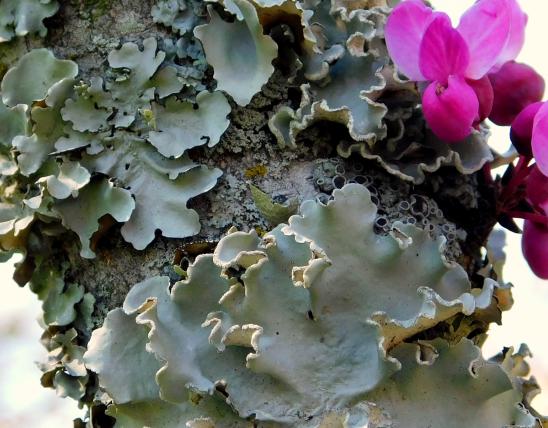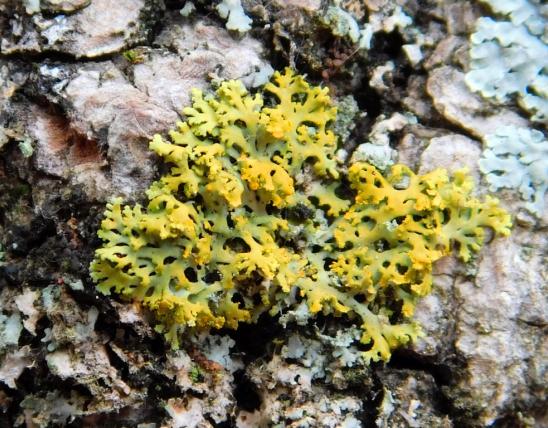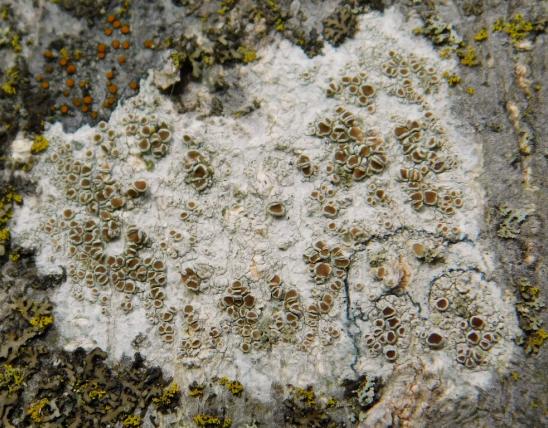
The star rosette lichen is a super common, small foliose lichen that most often grows on trees, including trunks, branches, and twigs. The pale gray thallus (main body) has crowded, narrow, branching, petal-like lobes. The undersides of the lobes are white. The overall shape of the thallus is circular or nearly circular (a rosette). The center of the rosette almost always has a cluster of apothecia (spore-producing) disks with black or dark gray centers; the rims of the apothecia are pale gray like the thallus. This species lacks soredia and isidia (two types of grainlike or powdery reproductive structures), but the central part of the lichen often appears warty.
Like other foliose lichens, rosette lichens grow outward from a central point and have a branching, lobed or petal-like structure. Foliose lichens usually have a definite lower surface.
A lichen is an organism that results when a fungus species and an algae species join together. Although the relationship between the fungi and algae is quite intimate and integrated, the lichen that is formed does not much resemble either of the components. Learn more about lichens on their group page.
Similar species: Of Missouri’s approximately 436 species of lichens, about 150 are ones with a more or less foliose growth form, and many of these grow in small, gray rosettes. They are confusingly similar, and because they are small, they are difficult for amateurs to identify. Missouri has about 30 species in the rosette lichen family (Physciaceae), and 10 in the genus Physcia. If you see a lichen and can recognize it as “some kind of rosette lichen,” you’re doing pretty well!
At most, a rosette of this small lichen usually only reaches about 1½ inches in diameter. They can occur in groups, however, that may cover large areas.
Statewide.
Habitat and Conservation
Like several other rosette lichens, star rosette lichen is a pioneer species that is often found growing on tree branches and twigs. It grows on trees in sun to part shade. Occasionally, it grows on rock. Often it grows amid other, larger lichens and is overlooked.
This species is very common throughout the United States.
Status
Very common. Often overlooked because it is so small.
Even though lichens may collectively cover large areas of trees, they are not parasites and do not damage trees.
Life Cycle
Lichens can reproduce sexually (via spores) or vegetatively (asexually, via grains that function tiny fragments of the lichen), but in this species, asexual reproduction is fairly rare, since it lacks the grainlike or powder soredia or isidia that other lichens may have.
Sexual reproduction in lichens occurs in much the same manner as other fungi. In this species, the spore-producing structures (apothecia) are disklike or buttonlike. When lichens reproduce via spores, only the fungal component is reproduced. The germinating fungal spore must quickly attach to a suitable algal partner, or it perishes.
Human Connections
Lichens are common yet mysterious. Late fall through early spring is a good time to look for them. Use a hand lens to examine these combo-organisms. Rosette lichens are small and rather hard to see, but they are there in plain sight for people who bother to pay attention to them. Their clusters of apothecia can look like tiny bouquets of flowers. Nature is full of humble species whose abiding companionship we simply haven’t acknowledged yet. Hello, fellow earthling!
The star rosette lichen is one of the lichen species that author Richard Headstrom points out in his classic natural history book Adventures with a Hand Lens: “as we peer at them through our lens we become breathless at the unexpected beauty.” It’s his “Adventure 7: We Visit Fairyland,” and it’s a fun read.
Ecosystem Connections
Many animals have markings and coloration that helps them blend in with the mottled background of lichen-covered bark. Examples include the backs of birds such as yellow-bellied sapsuckers and brown creepers, gray treefrogs, and the prairie lizard.
Tree trunks and branches are habitats unto themselves, and many insects that typically rest on tree trunks and limbs are lichen-camouflaged. Eyed click-beetles and eastern Hercules beetles are just a few of the many insects that blend in. Also, countless species of noctuid, underwing, sphinx, geometrid, and other night-flying moths rest unbothered during the day on tree trunks. They are hidden by their drab yet exquisitely ornate wing patterns; a green cast in many species helps them mimic lichens and mosses.




Mosses, liverworts, hornworts, and lichens seem rather similar, but these organisms are in very different groups. Mosses, liverworts, and hornworts are small, low plants usually found in damp habitats. Unlike more familiar plants, they lack veinlike structures and do not produce flowers or seeds — instead, they produce spores. Meanwhile, lichens are not plants at all: they are a collection of different fungi that have photosynthetic algae living within their tissues.





























